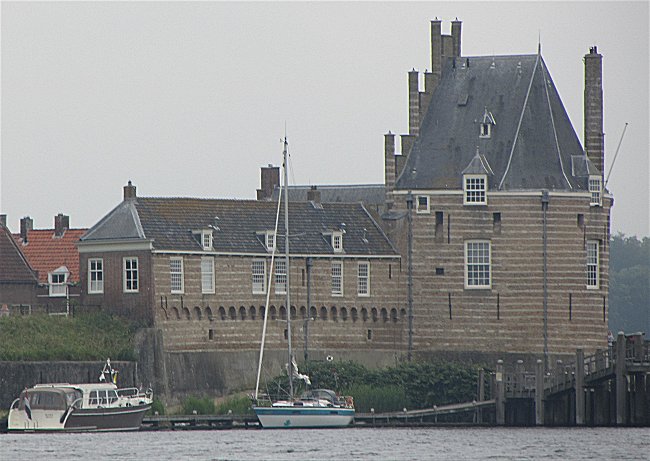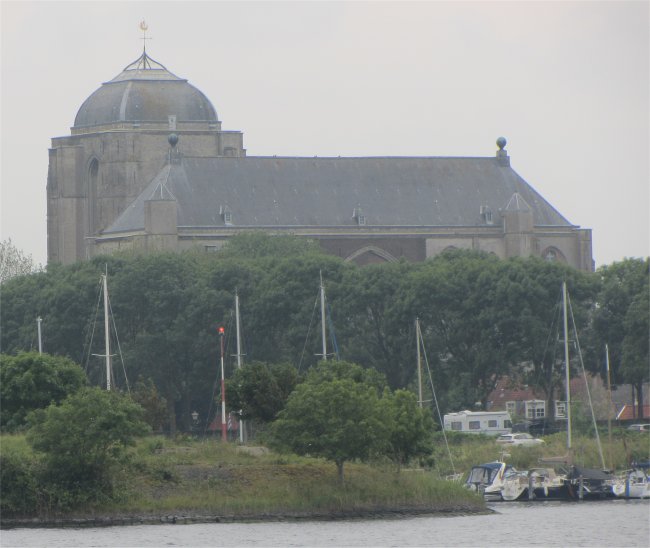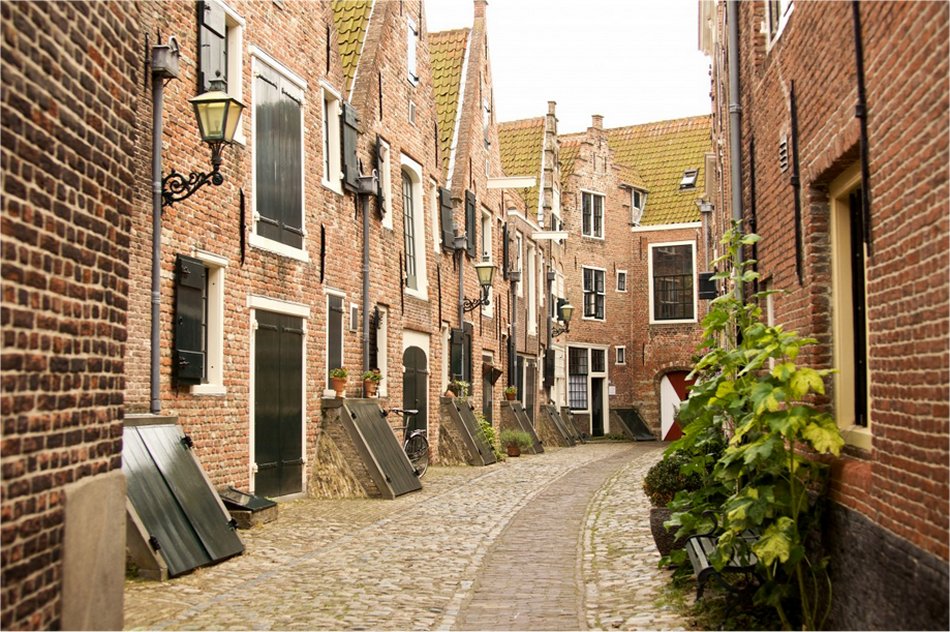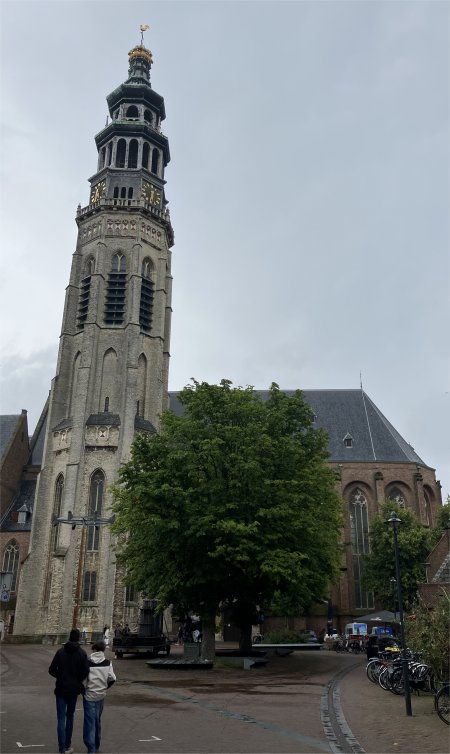The long, slow passage back up the beautiful canal was serene. The Brug Wilhelminadorp posed no problems, and true to form the two large boats behind wasted no time in overtaking us. The first was a massive, beamy Belgian boat with an equally beamy chap sitting in a deck chair inside the cockpit, as if he owned the canal. The second boat came from Shotley; much more down to earth.
In the Sluis Goese Sas, I had a chance to exchange a few words with the skipper from Shotley. He did indeed keep his yacht in Shotley marina. In former times he owned a long-keeled boat that he kept at the Royal Harwich Yacht Club. When I mentioned Rex kept Duonita on the saltings at Tollesbury, his eyes lit up.
"A charming place to keep a boat, " he exclaimed. He hadn't been to Tollesbury for a while since it was getting too shallow for him, but I pointed out that the marina is currently being dredged. "Ah, then I must sail back to Tollesbury again soon."
The couple had recently sailed across, calling in at Middelburg on the way. Now they were heading up to Strijensas, and further north after that. Like us, they were keen to get all their sailing in before the schools broke up in July.
Naturally we chatted about the ongoing football tournament, and he proudly announced that he had bought an orange flag to wave during the Dutch games. Meanwhile, we had dropped quite a way in the lock, and he was concerned that it was down to 1.8m below his keel Soon we were out of the lock, and we waved farewell to them and wished them a safe journey.
 Zandkreek Mud |
As we tied up to the waiting pontoon at the Zandkreeksluis, the sky filled up with hundreds of gulls. It was breeding season, and parents were busy bringing food to their squawking offspring. "A terrible din," commented Rex - a bit of an understatement. The Zandkreeksluis links the Veerse Meer to the Oosterschelde, and allows the meer to have brackish water, slightly less salty than sea water. In 2011, Rex, Alan and I moored up at an isolated pontoon near the sluis on our trip to St Petersburg. It all flooded back to me, it had been a grim night with winds screaming around us at speeds up to 30 knots.
Now it was a long, weaving passage along the Veerse Meer, passing endless marinas, chalets, boatyards, and even Kortgene. Here a huge holiday complex with chalets and caravans populated the shore, with a vast yacht marina on the opposite shore. Rex had fond memories of Kortgene; it was here in 2015 that he had another tooth filling. He collects fillings like other folk collect stamps or beer mats. Veerse Meer was certainly geared up for holiday makers!
 Serene Veerse Meer |
 Campveerse Toren |
A small plane passed overhead, and then steeply banked to avoid parachutists it had disgorged minutes earlier.
The charming, weaving route brought us to Veere, a small town we had visited in 2014. We had no intention of visiting Veere on this trip, but it is worthy of a glimpse into its past.
 Veere Town Hall Carillon Tower |
The small city of Veere stood on the Veerse Meer lagoon. The name literally meant "ferry", perhaps stemming from 1281 when Wolfert Van Borsselen established a ferry there. Veere received city rights in 1355. On 8th January 1488, the "Admiraliteit van Veere" (Admiralty of Veere) was set up as a result of the Ordinance on the Admiralty in an attempt to create a central naval administration in the Burgundian Netherlands. The Vice-Admiralty of Flanders in Dunkirk was subordinated to this. In 1560 under Admiral Philip de Montmorency, Count of Hoorn, this admiralty relocated near Ghent and in 1561 the Habsburg naval forces were also moved to Veere. The city functioned as the staple port for Scotland between 1541 and 1799.
Flemish architects Antonis Keldermans and Evert Spoorwater designed the Grote Kerk, the fortifications, the Cisterne and the town hall. Spoorwater was a visionary in a way, perfecting a method in which a detailed plan was made from which virtually all parts of a building could be manufactured at source, and upon delivery could be easily assembled with the aid of mortar. During this period of prosperity, the cultural centre was located at Sandenburgh castle, the residence of the noble Van Borsele and Van BourgondiŽ families. In the 17th and 18th centuries, Veere was a prosperous trading city, with about 750 houses inside the city walls then, compared to about 300 as of 2013. As a result of the damming of the Veerse Gat inlet in 1961, the fishing fleet of Veere moved to a new home port at Colijnsplaat on Noord-Beveland.
 Veere Grote Kerk |
 Kuiperspoort |
 Lange Jan |
Once out of the lock, we passed five huge lock gates propped up on the canal bank. I wondered if they were the same five we saw ten years earlier. Frisian cattle grazed the canal banks along this stretch of water. It wasn't long before we caught sight of Lange Jan, the tall tower that marked the presence of Middelburg.
Closer to the town, sheep grazed the canal banks, then industrial complexes hedged the canal. One large compound contained equally large pile-drivers, acting as sentinels to the northern edge of town. This was closely followed by a large compound occupied by stacks of large diameter steel pipes.
With the Stationsbrug ahead of us, we did a swift right turn into the Buitenhaven and moored up to a pontoon by the harbour master's office just in front of the Spijkerbrug. I checked us in, but there was a problem with their system - it was down. However, a paper chart helped (sometimes the old ways are better), and we were allocated box 21 in the Binnenhaven. I was promptly instructed to move the boat down there now since the Spijkerbrug was about to be opened.
We did this pretty smartly, and then I returned to the harbour master to pay our dues. The system was now working and Duonita was indeed already on their system. The harbour master told me she knew of the boat's home port since the previous year she had sailed to Maldon, and had been driven to Tollesbury. She also informed me that the Grand Banks boat in box 18 was owned by Steve Warner, another sailor from Tollesbury.
On my return to the boat, the intermittent light rain we had been experiencing for the last couple of hours turned to heavy rain. Welcome to Middelburg.
When the rain eased off, a quick trip to a SPAR was necessary for a few provisions. The cashier spoke good English. I soon learned she had grown up in Seattle, and then travelled to many places over the world with her family. I guessed she spoke more than just English.
We sat down and worked out a plan for the next few days. Then we set off to town, taking a detour via Kuiperspoort on the way. The Kuiperspoort, located almost on the opposite side of the Binnenhaven to where we were berthed, ran between Rouaanse Kaai and Dam Square. The name refers to the coopers' guild that was established here in the 17th century.
The beautiful, narrow street, paved with cobblestones, contains houses mainly dating from the second half of the sixteenth century. In the first half of the seventeenth century, the courtyard was purchased by the Kuipers Guild. A number of companies are now located in the former Kuiperhuizen, including the Walcheren art education foundation, where various painting and drawing lessons can be taken.
We then struck out and walked down past Lange Jan to the Markt, and enjoyed an excellent meal there while watching the first half of the Netherlands versus France match in the dying embers of sunshine. The temperature soon dropped. Coupled with that was the unfortunate fact that the restaurant was closing at 10pm. Thus, at half time, we headed back to Duonita for shelter from the approaching chill.
We watched the rest of the game on Rex's tablet; the 0:0 result was perhaps a just outcome. Rex was totally whacked out. I urged him to brush his teeth and go to bed. He didn't argue.
